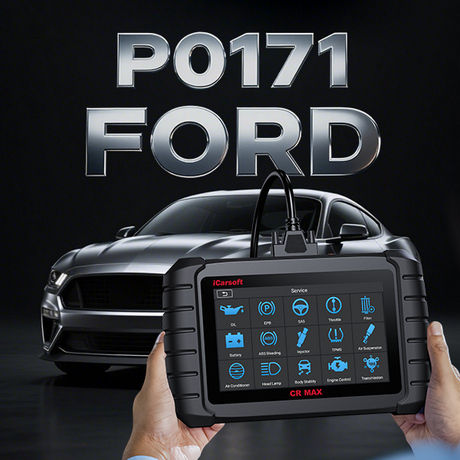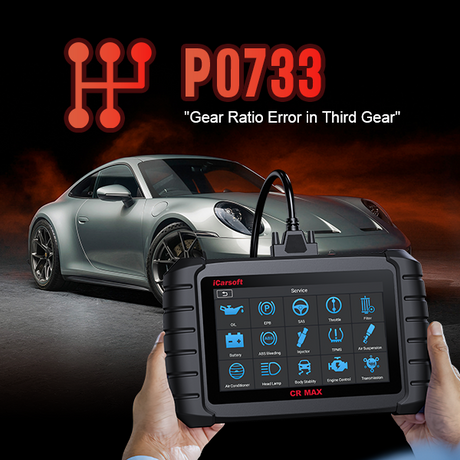Table of Contents
- 1. Understanding the Camshaft Sensor Circuit Issue
- 2. Recognizing Symptoms of Engine Timing Fault
- 3. Investigating Causes of Camshaft Error
- 4. Professional Methods for Diagnosing Trouble Codes
- 5. Comprehensive Steps to Resolve Sensor Issues
- 6. Proactive Measures to Prevent Engine Faults
- 7. Essential OBD II Scanner Tools for Camshaft Problems
- 8. Frequently Asked Questions About P0340
- 9. Concluding Insights on Maintaining Engine Health
1. Understanding the Camshaft Sensor Circuit Issue
Does your car stall unexpectedly or struggle to start? You might be dealing with a P0340 code issue, also known as a sensor circuit malfunction. This trouble code points to a problem with the camshaft position sensor—a small device near the cylinder head (the top part of your engine). Controlled by the powertrain control module (PCM), which is like the brain of your car’s engine, this sensor ensures accurate engine timing and smooth operation of the fuel injection systems. If it fails, you may notice reduced engine performance. Tools like the iCarsoft CR MAX or CR Eagle can help you diagnose this issue accurately.

2. Recognizing Symptoms of Engine Timing Fault
When an engine timing fault occurs, your vehicle will show clear signs. Look out for these symptoms:
- A steady check engine light on your dashboard
- Engine misfires or uneven idling, causing shakes
- Difficulty starting the car, or it won’t start at all
- Weak acceleration due to reduced power
- Sudden stalling or hesitation while driving

These warning signs often indicate a problem with the camshaft position sensor or its circuit. Ignoring them can lead to more serious issues, like engine damage, so it’s best to act quickly.
3. Investigating Causes of Camshaft Error
Several factors can cause a camshaft error. Let’s break them down:
Faulty Camshaft Sensor
A faulty camshaft position sensor can wear out over time, failing to send accurate signals to the powertrain control module (PCM).
Wiring Problems
Damaged or shorted circuits, often due to loose connections, can disrupt the sensor’s operation.
Powertrain Control Module Issues
A malfunctioning powertrain control module (PCM) might send incorrect signals, affecting the entire system.
Timing Chain Misalignment
A misaligned timing chain or belt can throw off the engine’s synchronization, leading to this error.
Oil Contamination
Oil sludge near the cylinder head can clog the sensor, especially if maintenance is neglected.
Crankshaft Sensor Interference
A related issue with the crankshaft position sensor—which works with the camshaft sensor—can also trigger this code.
Finding the exact cause requires careful checking and the right tools.
4. Professional Methods for Diagnosing Trouble Codes
A professional mechanic uses a systematic approach to diagnose a P0340 code Ford. With an OBD II scanner, they can:
- Check the camshaft position sensor’s output for irregularities
- Inspect wiring for shorted circuits or damage
- Monitor the powertrain control module’s signals for errors
- Ensure the timing chain or belt is properly aligned
Where Is the Camshaft Position Sensor?
If you’re doing it yourself, knowing where is the camshaft position sensor is key. It’s usually located near the cylinder head, but the exact spot varies by vehicle. The video below shows how to find and diagnose it on a Ford F150:
This guide can help vehicle owners troubleshoot with confidence, ensuring a thorough diagnosis.
5. Comprehensive Steps to Resolve Sensor Issues
Ready to fix this sensor circuit issue? Here’s how to tackle it:
- Replace the camshaft position sensor if it’s faulty—a simple task near the cylinder head. Look for a faulty camshaft sensor showing irregular readings.
- Repair or replace damaged wiring and connectors to restore the circuit.
- Reprogram or replace the powertrain control module if it’s sending wrong signals.
- Realign the timing chain or belt for proper synchronization.
- Clean oil buildup near the cylinder head or change the oil if it’s dirty, as this can affect the fuel injection systems.
Repair costs typically range from $50 to $200, depending on your vehicle. Labor charges may increase the total if you hire a professional.
6. Proactive Measures to Prevent Engine Faults
Prevent an engine timing fault with these habits:
- Inspect engine parts, like the fuel injection systems and crankshaft position sensor, every 6 months.
- Change oil every 5,000 miles (8,000 kilometers) to avoid sludge near the cylinder head.
- Check wiring for shorted circuits during routine maintenance.
- Replace the timing chain or belt as recommended in your manual—don’t wait for it to fail.
Regular maintenance keeps your fuel injection systems running smoothly.
7. Essential OBD II Scanner Tools for Camshaft Problems
To diagnose a trouble code accurately, use these tools:
- An OBD II scanner to retrieve error codes quickly
- A multimeter to test the camshaft position sensor circuit
- An oscilloscope to analyze waveform patterns
- A timing light to adjust engine timing precisely
We recommend the iCarsoft CR Eagle, which combines all these features into one easy-to-use device, perfect for professionals and DIYers alike.
Learn more about using diagnostic tools in our OBD II Scanner Guide.

8. Frequently Asked Questions About P0340
What does a P0340 code mean on a Ford F150?
A P0340 code Ford indicates a sensor circuit malfunction with the camshaft position sensor, affecting engine timing and causing issues like stalling or misfires.
How much does it cost to replace a camshaft position sensor?
Replacing a camshaft position sensor typically costs $50 to $200, depending on your vehicle and labor rates in your area.
Can I drive with a P0340 code?
Driving with a P0340 Ford F150 issue is not recommended. It can lead to reduced engine performance, stalling, or even engine damage if ignored.
9. Concluding Insights on Maintaining Engine Health
Don’t let a camshaft error disrupt your drive. A professional mechanic with tools like the iCarsoft CR MAX can quickly identify and fix the problem, keeping your fuel injection systems running smoothly. Act fast to protect your engine and save on costly repairs.
Skipping regular maintenance can cause this trouble code to return. Stay proactive with routine checks to ensure your engine runs efficiently.
Need help with other error codes? Check our P0300 Code Guide for more tips.













